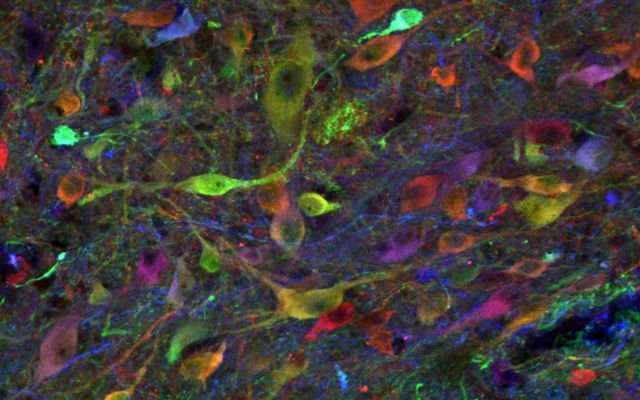Reprogrammed stem cell-derived neurons survive long-term in pigs with spinal cord injuries

A major hurdle to using neural stem cells derived from genetically different donors to replace damaged or destroyed tissues, such as in a spinal cord injury, has been the persistent rejection of the introduced material (cells), necessitating the use of complex drugs and techniques to suppress the host's immune response.
In a new paper, publishing May 9 in Science Translational Medicine, an international team led by scientists at University of California San Diego School of Medicine describe successfully grafting induced pluripotent stem cell (iPSC)-derived neural precursor cells back into the spinal cords of genetically identical adult pigs with no immunosuppression efforts. The grafted cells survived long-term, displayed differentiated functionality and caused no tumors.
The researchers also demonstrated that the same cells showed similar long-term survival in adult pigs with different genetic backgrounds after only short course use of immunosuppressive treatment once injected into injured spinal cord.
"The promise of iPSCs is huge, but so too have been the challenges. In this study, we've demonstrated an alternate approach," said senior author Martin Marsala, MD, professor in the Department of Anesthesiology at UC San Diego School of Medicine and a member of the Sanford Consortium for Regenerative Medicine.
"We took skin cells from an adult pig, an animal species with strong similarities to humans in spinal cord and central nervous system anatomy and function, reprogrammed them back to stem cells, then induced them to become neural precursor cells (NPCs), destined to become nerve cells. Because they are syngeneic—genetically identical with the cell-graft recipient pig—they are immunologically compatible. They grow and differentiate with no immunosuppression required."
Co-author Samuel Pfaff, PhD, professor and Howard Hughes Medical Institute Investigator at Salk Institute for Biological Studies, also noted: "Using RNA sequencing and innovative bioinformatic methods to deconvolute the RNA's species-of-origin, the research team demonstrated that pig iPSC-derived neural precursors safely acquire the genetic characteristics of mature CNS tissue even after transplantation into rat brains."
In their study, researchers grafted NPCs into the spinal cords of syngeneic non-injured pigs with no immunosuppression. The researchers found that the NPCs survived and differentiated into neurons and supporting glial cells at all observed time points. The grafted neurons were detected functioning seven months after transplantation.
Then researchers grafted NPCs into allogeneic (genetically dissimilar pigs) with chronic spinal cord injuries, followed by a transient four-week regimen of immunosuppression drugs. They found similar results with long-term cell survival and maturation.
"Our current experiments are focusing on generation and testing of clinical grade human iPSCs, which is the ultimate source of cells to be used in future clinical trials for treatment of spinal cord and central nervous system injuries in a syngeneic or allogeneic setting," said Marsala.
"Because long-term post-grafting periods—one to two years—are required to achieve a full grafted cells-induced treatment effect, the elimination of immunosuppressive treatment will substantially increase our chances in achieving more robust functional improvement in spinal trauma patients receiving iPSC-derived NPCs."
"In our current clinical cell-replacement trials, immunosuppression is required to achieve the survival of allogeneic cell grafts. The elimination of immunosuppression requirement by using syngeneic cell grafts would represent a major step forward" said co-author Joseph Ciacci, MD, a neurosurgeon at UC San Diego Health and professor of surgery at UC San Diego School of Medicine.
More information: J. Strnadel el al., "Survival of syngeneic and allogeneic iPSC–derived neural precursors after spinal grafting in minipigs," Science Translational Medicine (2018). stm.sciencemag.org/lookup/doi/ … scitranslmed.aam6651















